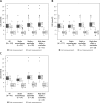Clinical management of heterozygous familial hypercholesterolemia in a Polish outpatient metabolic clinic: a retrospective observational study
- PMID: 30154876
- PMCID: PMC6111347
- DOI: 10.5114/aoms.2017.71855
Clinical management of heterozygous familial hypercholesterolemia in a Polish outpatient metabolic clinic: a retrospective observational study
Abstract
Introduction: There are currently no reports available from a Polish clinical practice on heterozygous familial hypercholesterolemia (HeFH) management. The aim of this study was to test the efficacy of HeFH hypolipidemic treatment in a Polish outpatient metabolic clinic according to treatment targets outlined in the European Atherosclerosis Society (EAS) and European Society of Cardiology (ESC) guidelines.
Material and methods: This retrospective, observational study was performed on HeFH patients who attended their routine follow-up visits in the metabolic outpatient clinic in the period between April and September 2016. According to EAS/ESC guidelines, the goal and intensity of therapy were assigned individually for every patient based on cardiovascular (CV) risk (high or very high). The treatment target was achievement of low-density lipoprotein cholesterol (LDL-C) levels < 1.8 mmol/l for very high CV risk patients and < 2.6 mmol/l for high CV risk patients. A ≥ 50% decrease in LDL-C over the observation period was an additional outcome measure.
Results: In the overall group of 222 HeFH patients (mean age: 55.2 ±16.2 years, 72% women), LDL-C levels decreased on average by 52.6% (p < 0.001). More than half of the patients were treated with the maximum tolerated dose of statins. A total of 25.2% of patients attained target levels of LDL-C and 55.9% attained a ≥ 50% reduction in its concentration. Despite therapy, significantly elevated post-follow-up levels of LDL-C (> 4.1 mmol/l) remained in 14% of all patients.
Conclusions: Hypolipidemic therapy according to EAS/ESC guidelines was suboptimal for a significant number of HeFH patients. Additional clinical management should be considered.
Keywords: efficacy; familial hypercholesterolemia; lipid-lowering therapy; outpatient clinic.
Conflict of interest statement
LKL and BC received honoraria for advisory boards from Angen and Sanofi. BC received honoraria for advison board from MSD.
Figures

Similar articles
-
[Severe hypercholesterolaemia--when to use the proprotein convertase subtilisin-kexin type 9 protease inhibitors (PCSK9 inhibitors)? Polish Society of Cardiology experts' group statement].Kardiol Pol. 2016;74(4):394-8. doi: 10.5603/KP.2016.0051. Kardiol Pol. 2016. PMID: 27098076 Polish.
-
LDL cholesterol target achievement in heterozygous familial hypercholesterolemia patients according to 2019 ESC/EAS lipid guidelines: Implications for newer lipid-lowering treatments.Int J Cardiol. 2021 Dec 15;345:119-124. doi: 10.1016/j.ijcard.2021.10.024. Epub 2021 Oct 21. Int J Cardiol. 2021. PMID: 34687802
-
How effective are the ESC/EAS and 2013 ACC/AHA guidelines in treating dyslipidemia? Lessons from a lipid clinic.Curr Med Res Opin. 2015 Feb;31(2):221-8. doi: 10.1185/03007995.2014.982751. Epub 2014 Nov 24. Curr Med Res Opin. 2015. PMID: 25418708
-
Old challenges and new opportunities in the clinical management of heterozygous familial hypercholesterolemia (HeFH): The promises of PCSK9 inhibitors.Atherosclerosis. 2017 Jan;256:134-145. doi: 10.1016/j.atherosclerosis.2016.09.001. Epub 2016 Sep 2. Atherosclerosis. 2017. PMID: 27993383 Review.
-
Familial hypercholesterolemia and elevated lipoprotein(a): double heritable risk and new therapeutic opportunities.J Intern Med. 2020 Jan;287(1):2-18. doi: 10.1111/joim.12981. J Intern Med. 2020. PMID: 31858669 Review.
Cited by
-
Safety of ezetimibe in lipid-lowering treatment: systematic review and meta-analysis of randomised controlled trials and cohort studies.BMJ Med. 2022 May 3;1(1):e000134. doi: 10.1136/bmjmed-2022-000134. eCollection 2022. BMJ Med. 2022. PMID: 36936552 Free PMC article.
References
-
- Raal FJ, Santos RD. Homozygous familial hypercholesterolemia: current perspectives on diagnosis and treatment. Atherosclerosis. 2012;223:262–8. - PubMed
-
- Santos RD, Gidding SS, Hegele RA, et al. Defining severe familial hypercholesterolaemia and the implications for clinical management: a consensus statement from the International Atherosclerosis Society Severe Familial Hypercholesterolemia Panel. Lancet Diabetes Endocrinol. 2016;4:850–61. - PubMed
-
- Di Taranto MD, D’Agostino MN, Fortunato G. Functional characterization of mutant genes associated with autosomal dominant familial hypercholesterolemia: integration and evolution of genetic diagnosis. Nutr Metab Cardiovasc Dis. 2015;25:979–87. - PubMed
LinkOut - more resources
Full Text Sources
Other Literature Sources
Miscellaneous
